F&Y2 Wave 9, Chapter 6: Eating at home
This chapter provides an overview of respondents’ knowledge and reported behaviours relating to food safety and other food-related behaviours.
Introduction
The FSA is responsible for protecting the public from foodborne diseases. This involves working with farmers, food producers and processors, and the retail and hospitality sectors to ensure that the food people buy is safe. The FSA gives practical guidance and recommendations to consumers on food safety and hygiene in the home.
The Food and You 2 survey asks respondents about their food-related behaviours in the home, including whether specific foods are eaten, and knowledge and reported behaviour in relation to five important aspects of food safety: cleaning, cooking, chilling, avoiding cross-contamination and use-by dates. Food and You 2 also asks respondents about the frequency they prepare or consume certain types of food.
Two versions of the ‘Eating at home’ module have been created; a ‘core’ module which includes a limited number of key questions which are fielded annually, and a ‘deep dive’ module which includes additional questions and is fielded every 2 years. This chapter reports on the deep dive ‘Eating at home’ module (footnote 1).
This chapter provides an overview of respondents’ knowledge and reported behaviours relating to food safety and other food-related behaviours.
Cleaning
Handwashing in the home
The FSA recommends that everyone should wash their hands before they prepare, cook or eat food, after handling raw food and before preparing ready-to-eat food.
Whilst most respondents (70%) reported that they always wash their hands before preparing or cooking food, 29% reported that they do this most of the time or less often, and 1% reported never doing this (footnote 2).
Most respondents (92%) reported that they always wash their hands immediately after handling raw meat, poultry, or fish, 8% reported that they do this most of the time or less often (footnote 3).
Just under half of respondents (47%) reported that they always wash their hands before eating, 50% reported doing this most of the time or less often, and 2% reported never washing their hands before eating.
Handwashing when eating out
Respondents were asked, how often, if at all, they washed their hands or used hand sanitising gel or wipes before eating outside of their home. Around a third of respondents (31%) reported that they always washed their hands, used hand sanitising gel or wipes when they ate outside of their home, 59% did this most of the time or less often and 9% never did this (footnote 4).
Chilling
The FSA provides guidance on how to chill food properly to help stop harmful bacteria growing.
If and how respondents check refrigerator (fridge) temperature
When asked what temperature the inside of a fridge should be, 59% of respondents who have a fridge, reported that it should be between 0-5 degrees Celsius, as recommended by the FSA. A fifth of respondents (20%) reported that the temperature should be above 5 degrees, 3% reported that the temperature should be below 0 degrees, and 17% of respondents did not know what temperature the inside of their fridge should be (footnote 5).
Over half of respondents (57%) who have a fridge reported that they monitored the temperature or relied on an alarm to alert them to a temperature that is too warm or too cold (footnote 6). Of the respondents who monitor the temperature of their fridge, around half (48%) reported that they check the temperature of their fridge at least once a week or more often, as recommended, while 2% reported that they never check or check less often than once a year (footnote 7). Amongst those who check, most respondents checked the temperature of their fridge using a thermometer, the settings/gauge or built in display (86%), however 12% checked for ice/condensation or felt the food inside to check if it’s cold (footnote 8).
Defrosting
The FSA recommends that food is defrosted in the fridge, or, if this is not possible to use a microwave on the defrost setting. The FSA advises consumers not to defrost foods at room temperature.
Respondents were asked which method they typically use to defrost meat and fish. Around four in ten respondents (43%) reported that they defrost meat or fish in the fridge and 6% reported that they use a microwave. Around four in ten (42%) reported that they leave the meat or fish at room temperature and 6% leave the meat or fish in water (footnote 9).
Cooking
The FSA recommends that cooking food at the right temperature and for the correct length of time will ensure that any harmful bacteria are killed. When cooking pork, poultry, and minced meat products the FSA recommends that the meat is steaming hot and cooked all the way through, that none of the meat is pink and that any juices run clear.
Most respondents (80%) reported that they always cook food until it is steaming hot and cooked all the way through, however 20% reported that they do not always do this (footnote 10).
Respondents were asked to indicate how often they eat different types of meat when the meat is pink or has pink juices. Around nine in ten respondents reported that they never eat sausages (94%), chicken or turkey (92%), or whole cuts of pork or pork chops (91%) when it is pink or has pink juices. Around two-thirds of respondents reported that they never eat duck (68%) or beef burgers (66%) when it is pink or has pink juices; but around a third reported that they do eat these at least occasionally (29% of those eating duck, and 33% of those eating beef or beef burgers). Around two-thirds of respondents (65%) reported eating red meat when it is pink or has pink juices at least occasionally (Figure 18) (footnote 11).
Figure 18. How often respondents eat different types of meat when it is pink or has pink juices
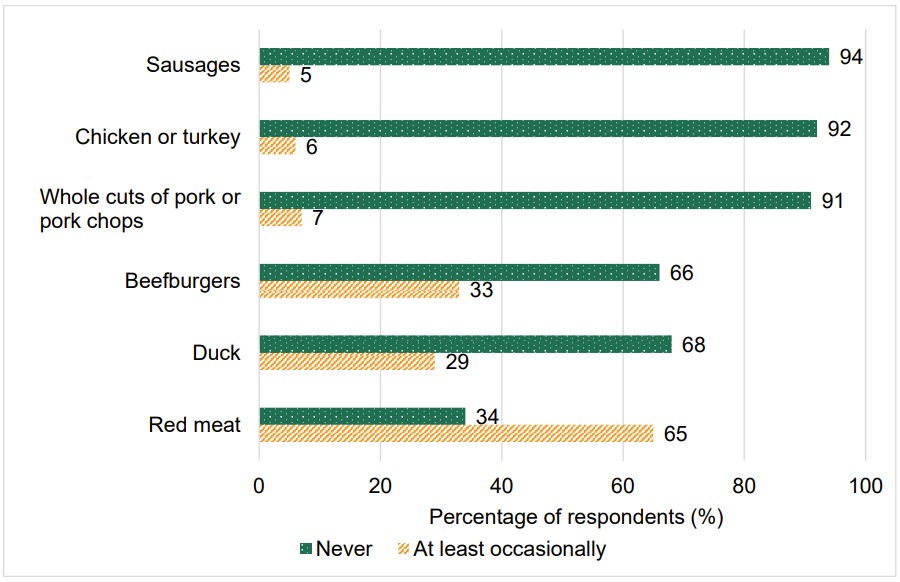
Source: Food and You 2: Wave 9
Respondents were asked how often, if at all, they consume raw oysters or raw (unpasteurised) milk. Most respondents reported that they never eat raw oysters (85%) or unpasteurised/raw milk (89%) (footnote 12).
Respondents were asked how often they follow packaging instructions when preparing frozen fruit and vegetables. Around a third (35%) reported that they always follow packaging instructions, 24% reported doing this most of the time and 15% reported that they never do this (footnote 13).
Reheating
Respondents were asked to indicate how they check food is ready to eat when they reheat it. The most common method was to check the middle is hot (54%), and the least common methods were to put a hand over the food or touch the food (17%) or use a thermometer or probe (12%) (Figure 19) (footnote 14).
Figure 19. How respondents check whether reheated food is ready to eat
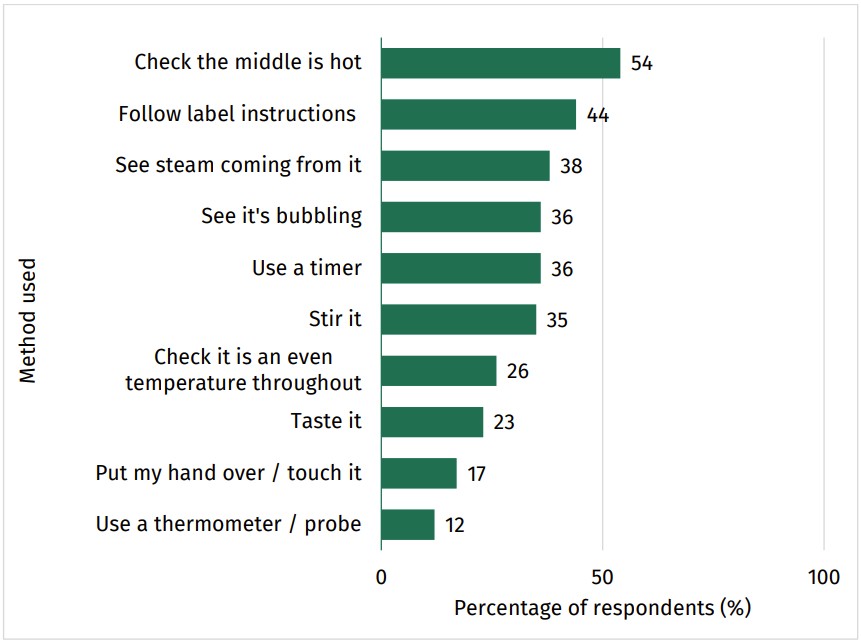
Source: Food and You 2: Wave 9
The FSA recommends that food is only reheated once. When respondents were asked how many times they would reheat food, the majority reported that they would only reheat food once (83%), 10% would reheat food twice, and 3% would reheat food more than twice (footnote 15).
Leftovers
FSA advice is to cool and store leftovers in the fridge within 2 hours of cooking. Leftovers should be eaten within 48 hours, or frozen.
Respondents were asked what they do with leftovers following a meal. The majority of those who reported having leftovers (71%) stated that they would put them in the fridge, and 9% stored them in the freezer. A minority reported leaving them at room temperature to eat the same day (2%), or the next day (3%) (Figure 20) (footnote 16).
Figure 20. What respondents do with leftovers following a meal
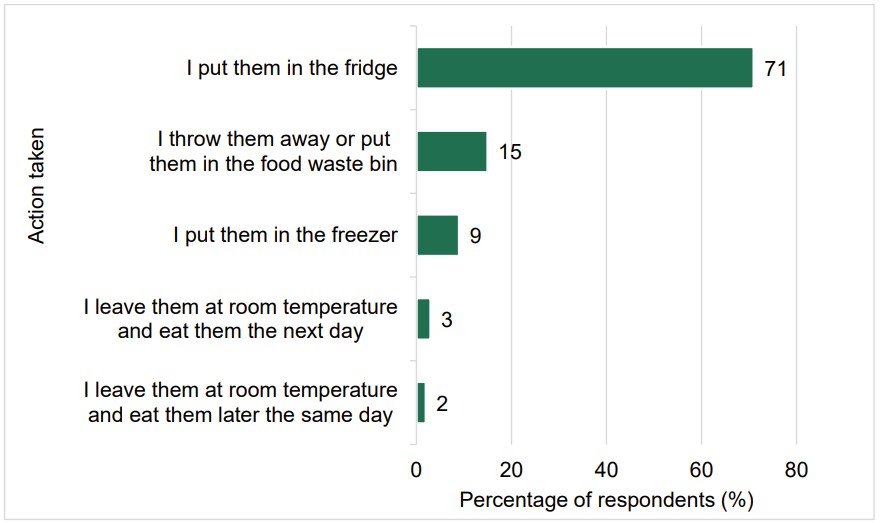
Source: Food and You 2: Wave 9
Respondents who reported that they put leftovers in the fridge or freezer were asked to indicate how soon after cooking they would typically put leftovers into the fridge or freezer. Most respondents reported that they typically placed leftovers in the fridge or freezer within one hour (34%) or one to two hours of cooking (43%). Around a fifth of respondents (18%) put leftovers in the fridge or freezer after more than two hours, and 5% would put leftovers in the fridge or freezer straight away (footnote 17).
Respondents were asked the latest that they would consume leftovers that had been stored in the fridge. Two-thirds of respondents (66%) reported that they would eat leftovers within 2 days, 25% of respondents reported that they would eat leftovers within 3-5 days and 2% would eat leftovers more than 5 days later (footnote 18).
Avoiding cross-contamination
The FSA provides guidelines on how to avoid cross-contamination. The FSA recommends that people do not wash raw meat, fish or poultry. Washing raw meat, fish and poultry can splash harmful bacteria onto hands, work surfaces, ready-to-eat foods and cooking equipment.
Around four in ten respondents reported that they wash raw fish or seafood (40%) or raw chicken (38%) at least occasionally. Around three in ten (28%) reported that they wash raw lamb, beef or pork at least occasionally, and a quarter of respondents (25%) reported that they wash raw duck, goose or turkey at least occasionally (Figure 21) (footnote 19).
Figure 21. How often respondents wash different types of raw meat or fish
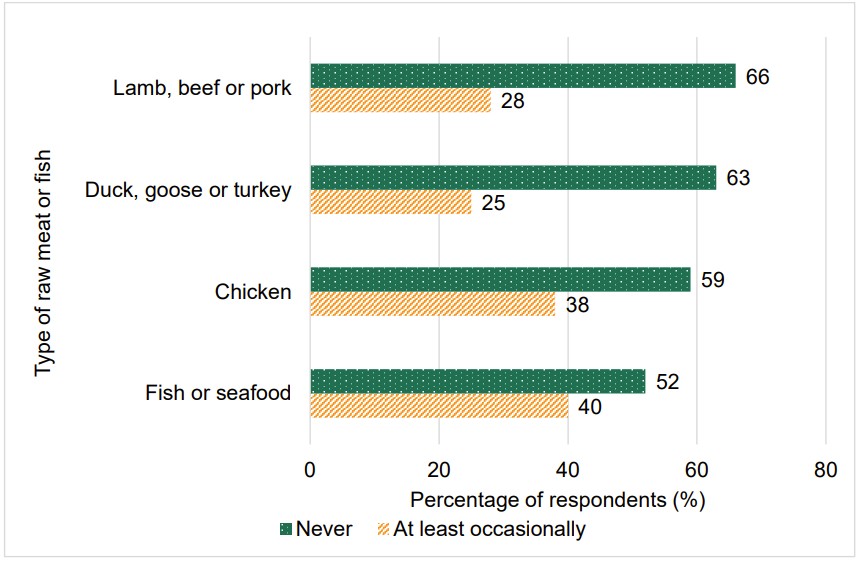
Source: Food and You 2: Wave 9
Chopping board use
Respondents were asked how they use chopping boards when they prepare raw meat and other foods. Around half of respondents (54%) reported that they use different chopping boards for raw meat and other foods and 35% of respondents reported that they wash the chopping board between preparing raw meat and other foods. Fewer respondents reported using the same chopping board (without washing) (8%) or turning the chopping board over between preparing raw meat and other foods (3%) (footnote 20).
Respondents who use the same chopping board to prepare raw meat and other foods were asked in which order they prepare the foods. Over a half of respondents (55%) reported that they prepare other foods before raw meat. Around a quarter of respondents (23%) reported that they prepare raw meat before other foods and 21% of respondents reported that they don’t think about the order in which they prepare foods (footnote 21).
How and where respondents store raw meat and poultry in the fridge
The FSA recommends that refrigerated raw meat and poultry are kept covered, separately from ready-to-eat foods and stored at the bottom of the fridge to avoid cross-contamination.
Respondents were asked to indicate, from a range of responses, how they store raw meat and poultry in the fridge. Respondents were most likely to report storing raw meat and poultry in its original packaging (63%) or away from cooked foods (43%). Around a third of respondents reported storing raw meat and poultry in a sealed container (33%) and covered raw meat and poultry with film/foil (29%), with 13% keeping the product on a plate (footnote 22).
Most respondents (60%) reported only storing raw meat and poultry at the bottom of the fridge, as recommended by the FSA. However, 24% of respondents reported storing raw meat and poultry wherever there is space in the fridge, 11% reported storing raw meat and poultry in the middle of the fridge, and 6% at the top of the fridge (footnote 23).
Using separate shopping bags
Around a fifth of respondents (22%) reported always using a separate shopping bag for raw meat, fish or shellfish (away from other food items) as recommended by the FSA. However, a larger proportion (27%) reported that they never do this (footnote 24).
Use-by and best before dates
Respondents were asked about their understanding of the different types of date labels and instructions on food packaging, as storing food for too long or at the wrong temperature can cause food poisoning. Use-by dates relate to food safety. Best before (BBE) dates relate to food quality.
Respondents were asked to indicate which date shows that food is no longer safe to eat. Around two-thirds of respondents (67%) correctly identified the use-by date as the information which shows that food is no longer safe to eat. However, 9% of respondents identified the best before date as the date which shows food is no longer safe to eat (footnote 25).
Around six in ten respondents (62%) reported that they always check use-by dates before they cook or prepare food, 34% reported checking use-by dates most of the time or less often, and 2% reported never checking use-by dates (footnote 26).
Respondents who eat particular foods were asked when, if at all, is the latest that they would eat the type of food after the use-by date. Most respondents reported that they would not eat shellfish (74%), or other fish (64%) past the use-by date. Around half of respondents would not eat raw meat (53%) or smoked fish (51%) past the use-by date. Bagged salad (72%) and cheese (70%) were the foods respondents were most likely to report eating at any point after the use-by date. Around six in ten respondents would eat yoghurt (63%), milk (60%), or cooked meats (58%) at any point after the use-by date (Figure 22) (footnote 27).
Figure 22. How long after the use-by date respondents would consume different foods
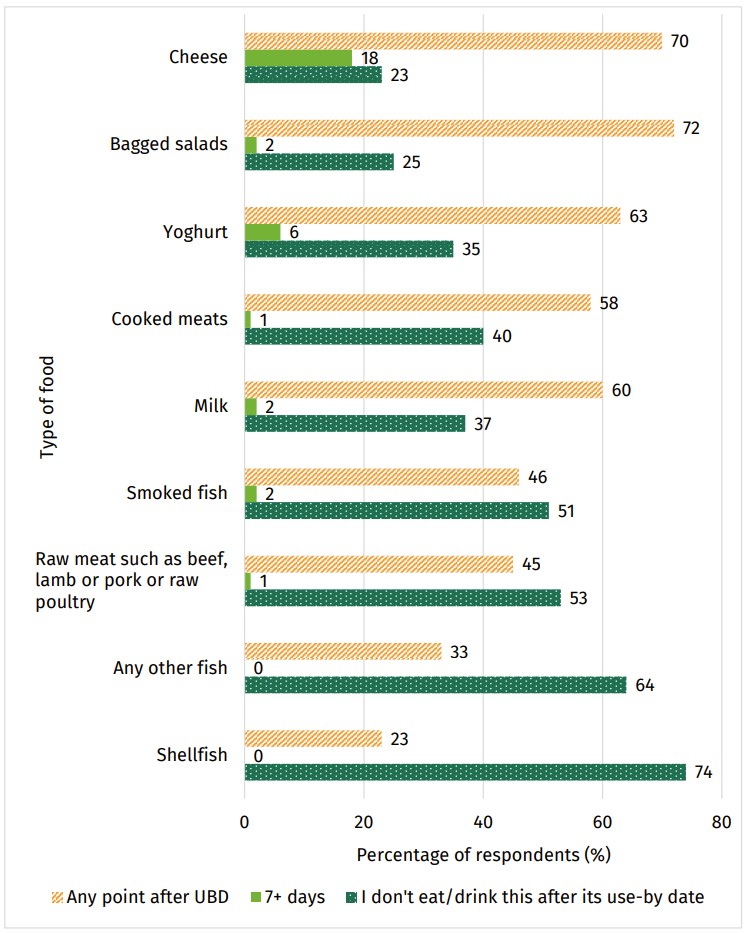
Source: Food and You 2: Wave 9
Respondents were asked what they usually do with food they have bought which is about to go out of date. The majority of respondents reported that they would usually either eat the food (35%) or freeze it by the use-by date (29%). Fewer respondents would throw away the food after the use-by date (12%) or keep it and eat it after the use-by date (7%), however, 15% of respondents reported that it varies too much to say (footnote 28).
Respondents were asked to indicate how they tell whether different foods are safe to eat or cook with. The method which respondents used to assess whether food is safe to eat or cook varied by food type. Smell was most often used to assess raw meat (76%) and milk and yogurt (73%). Respondents most often relied on the use-by date to assess whether fish (75%) and dried or cured meats (66%) were safe to eat or cook with. How the food smells (65% for fish and 50% for dried and cured meats) and how it looks (47% for fish and 47% for dried and cured meats) were also commonly used to assess these items. Eggs were typically assessed using the best before date (59%) and cheese was most often assessed by how it looks (66%) (Figure 23) (footnote 29).
Figure 23. How respondents tell whether different foods are safe to eat or cook with
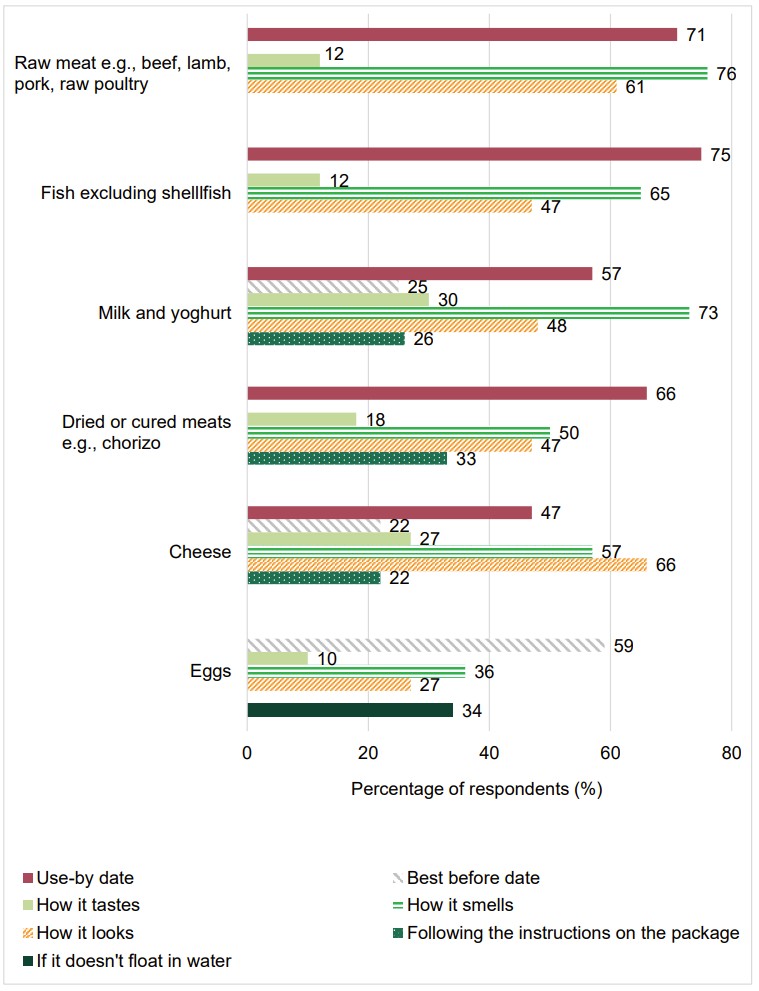
Source: Food and You 2: Wave 9 (footnote 30)
‘Eat within’ information
Some foods have instructions on the label which advise that the food should be eaten within a few days of opening. Respondents were asked to indicate how often they follow this recommendation. Around a quarter of respondents (26%) reported that they always follow the on-pack instruction. However, most respondents (68%) reported that they do not always (most of the time, about half the time or occasionally) follow the on-pack instructions and 6% reported that they never do this (footnote 31).
-
The deep dive ‘Eating at home’ module was last reported in the Food and You 2: Wave 5 Key Findings report. The core module was last reported in the Food and You 2: Wave 8 Key Findings report.
-
Question: When you are at home, how often, if at all, do you wash your hands before starting to prepare or cook food. Responses: always, most of the time, about half the time, occasionally, never, don’t know. Base= 4307, all online respondents and all those who completed Version A of the postal questionnaire, who ever do some food preparation or cooking for their household.
-
Question: When you are at home, how often, if at all, do you wash your hands immediately after handling raw meat, poultry or fish. Responses: always, most of the time, About half the time, Occasionally, Never, I don’t cook meat, poultry or fish, Don’t know. Base= 4111, all online respondents and those who completed Version A of the postal questionnaire who ever do some food preparation or cooking for their household, excluding `I don't cook meat, poultry or fish' and 'not stated'. 67 Question: When you are at home, how often, if at all, do you wash your hands before eating. Responses: always, most of the time, about half the time, occasionally, never, don’t know. Base= 4634, all online respondents and those who completed Version A of the postal questionnaire.
-
Question: When eating outside of the home, how often, if at all, do you wash your hands, or use hand sanitising gel or wipes before eating? Responses: always, most of the time, about half the time, occasionally, never, don’t know. Base= 4634, all online respondents, and those who completed Version A of the postal questionnaire
-
Question: What do you think the temperature inside your fridge should be? Responses: less than 0 degrees C (less than 32 degrees F), between 0 and 5 degrees C (32 to 41 degrees F), more than 5 but less than 8 degrees C (42 to 46 degrees F), 8 to 10 degrees C (47 to 50 degrees F), more than 10 degrees C (over 50 degrees F), other, don’t know. Base=5513, all respondents, excluding those who don't have a fridge. 70 Question: Do you, or anyone else in your household, ever check your fridge temperature? Responses: yes, no, I don't need to - it has an alarm if it is too hot or cold, don’t know. Base= 5501, all respondents, excluding those who don't have a fridge.
-
Question: Do you, or anyone else in your household, ever check your fridge temperature? Responses: yes, no, I don't need to - it has an alarm if it is too hot or cold, don’t know. Base= 5501, all respondents, excluding those who don't have a fridge.
-
Question: How often, if at all, do you or someone else in your household check the temperature of the fridge? Responses: at least daily, 2-3 times a week, once a week, less than once a week but more than once a month, once a month, four times a year, 1- 2 times a year, never/less often, don’t know. Base= 2663, all online respondents and all those who completed the `Eating at Home' questionnaire where someone in household checks fridge temperature.
-
Question: How do you (or someone else in your household) normally check the temperature? Responses: Check the setting / gauge, check the temperature display built into the fridge, put a thermometer in the fridge and check, check for ice or condensation, feel food inside to see if it is cold, don’t know, Other. Base= 2663, all respondents where someone in household checks fridge temperature.
-
Question: Typically, how do you defrost frozen meat or fish? Responses: place the meat or fish in water, leave the meat or fish at room temperature (e.g. on the worktop on a plate, in a container or in its packaging), leave the meat or fish in the fridge, defrost the meat or fish in the microwave oven, some other way, don’t know. Base= 3695, all online respondents and those who answered the version B postal questionnaire who ever do some food preparation or cooking for their household, excluding those who never defrost meat or fish.
-
Question: How often, if at all, do you cook food until it is steaming hot and cooked all the way through? Responses: always, most of the time, about half of the time, occasionally, never, don’t know. Base= 5109, all respondents who ever do some food preparation or cooking for their household.
-
Question: How often, if at all, do you eat...a=chicken or turkey, b=red meat, c=duck, d=beefburgers, e=sausages, f=whole cuts of pork or pork chops… when the meat is pink or has pink or red juices? Responses: always, most of the time, about half of the time, occasionally, never, don’t know. Base A=5079, B=3145, C= 2338, D=2982, E=3092, F=2882, all respondents who are not vegan, pescatarian or vegetarian, and who do eat A/B/C/D/E/F
-
Question: How often, if at all, do you eat...b = raw oysters/ c= raw (that is, unpasteurised) milk? Responses: about once a week or more often, about once a fortnight, about once a month, about once every 3 months, about once a year, less than once a year, never. Base B=5297, C= 5464, all online and postal respondents who are not…B= vegan or vegetarian / C = vegan.
-
Question: When preparing frozen vegetables or frozen fruit, how often do you follow instructions on the packaging? Responses: always, most of the time, about half the time, occasionally, never, I don’t use frozen vegetables or frozen fruit, don’t know. Base= 4079, All online respondents, and those who answered the version B postal questionnaire, who ever do some food preparation or cooking for their household.
-
Question: When reheating food, how do you know when it is ready to eat? (Select all that apply). Responses: I check the middle is hot, I follow the instructions on the label, I can see its bubbling, I use a timer to ensure it has been cooked for a certain amount of time, I check it's an even temperature throughout, I can see steam coming from it, I taste it, I stir it, I put my hand over it/touch it, I use a thermometer/probe, None of the above, I don't check. Base= 4877, all online and postal respondents who ever do some food preparation or cooking for their household, excluding ‘I don't reheat food' and ‘not stated'.
-
Question: How many times would you consider reheating food after it was cooked for the first time? Responses: not at all, once, twice, more than twice, don’t know. Base= 4890, all online and postal respondents who reheat food using one of the methods in the previous question.
-
Question: Generally, what do you do with any leftovers following a meal? Responses: I throw them away or put them in the food waste bin, I leave them at room temperature and eat them later the same day, I leave them at room temperature and eat them the next day, I put them in the fridge, I put them in the freezer. Base = 4,067, all online respondents and those answering the Postal B version of the questionnaire, excluding those who don’t have leftovers.
-
Question: Typically, how soon after cooking do you put any leftovers in the fridge or freezer? Responses: straight away, within 1 hour of cooking, 1 - 2 hours after cooking, more than 2 hours after cooking, don’t know. Base= 3239, all online respondents and those who completed version B of the postal questionnaire, who leave leftovers in a fridge or freezer.
-
Question: When is the latest you would consume any leftovers stored in the fridge? Responses: the same day, within 1-2 days, within 3-5 days, more than 5 days later, it varies too much, don't know. Base= 5526, all online and postal respondents.
-
Question: How often, if at all, do you do the following? a=wash raw chicken, b= wash raw duck, goose or turkey, c= wash raw lamb, beef or pork, d= wash raw fish or seafood. Responses: always, most of the time, about half of the time, occasionally, never, don’t know. Base = 5109, all respondents who ever do some food preparation or cooking for their household.
-
Question: Typically, how do you use chopping boards when preparing a meal with raw meat? Responses: I use a different chopping board for raw meat and other foods, I wash the chopping board between preparing raw meat and other foods, I turn the chopping board over between preparing raw meat and other foods, I use the same chopping board for preparing raw meat and other foods (without washing the board). Base= 3615, all online respondents and those who answered the version B postal questionnaire, who ever do some food preparation or cooking for their household, excluding those who don't use chopping boards or those who don't cook with raw meat.
-
Question: When you use the same chopping board to prepare raw meat and other foods, in which order do you prepare food? Responses: I prepare raw meat before other foods, I prepare other foods before raw meat, I don't think about the order I prepare foods, Don’t know. Base=210, all online respondents and all those who completed the version B postal questionnaire who do some food preparation or cooking and use the same chopping board to prepare meat and other foods without washing the board.
-
Question: How do you store raw meat and poultry in the fridge? Please select all that apply. Responses: away from cooked foods, covered with film/foil, in a sealed container, in its original packaging, on a plate. Base= 3984, all online respondents and all those who completed Version B of the postal questionnaire, except those who don't buy/store meat/poultry, don't store raw meat/poultry in the fridge, do not have a fridge or don't know.
-
Question: Where in the fridge do you store raw meat and poultry? Responses: wherever there is space, at the top of the fridge, in the middle of the fridge, at the bottom of the fridge. Base= 3905, all online respondent and all those who completed Version B of the postal questionnaire who store raw meat/poultry in the fridge except those who don't buy/store meat/poultry, don't have a fridge, or don't know.
-
Question: When shopping for raw meat, fish or shellfish, do you put it in a completely separate shopping or carrier bag away from other food items? Responses: yes, always; yes, most of the time; yes, about half of the time; occasionally; no, never; I never buy raw meat, fish or shellfish. Base= 3304, all online respondents who ever do food shopping.
-
Question: Which of these shows when food is no longer safe to eat? Responses: useby date, best before date, sell by date, display until date, all of these, it depends, none of these, don’t know. Base= 5526, all respondents (postal and online).
-
Question: How often, if at all, do you check use-by dates when you are about to cook or prepare food? Responses: always, most of the time, about half of the time, occasionally, never, it varies too much to say, don’t know. Base= 5109 all respondents (postal and online) who ever do some food preparation or cooking for their household.
-
Question: When, if at all, is the latest you would eat or drink the following items after their use-by date? a=cooked meats, b=smoked fish, c=bagged salads, d=cheese, e=milk, f= raw meat such as beef/pork/lamb/raw poultry, g=shellfish, h=any other fish, i=yoghurt. Responses: 1-2 days after the use-by date, 3-4 days after the use-by date, 5- 6 days after the use-by date, 1-2 weeks after the use-by date, more than 2 weeks after the use-by date, I don't eat/drink this after its use-by date, don't know/I don't ever check the use-by date of this. Base A= 3964, B=3013, C=4010, D=4184, E=4117, F=3911, G=2504, H=3422, I=4033, all online respondents and those who completed Version B of the postal questionnaire, who eat A/B/C/D/F/F/G/H/I. Please note: the figures shown do not add up to 100% as not all responses are shown.
-
Question: When food you have bought is about to go past its use-by date, which of the following do you usually do? Responses: I eat it by the use-by date, I freeze it by the use-by date, I throw it away (after the use-by date), I keep it and eat it after the use-by date, it varies too much to say, I don't check use-by dates. Base = 5526, all respondents.
-
Question: How do you tell whether it is safe to eat or cook with...? a) raw meat like beef, lamb, pork or poultry, b) milk and yoghurt, c) cheese, d) eggs, e) fish (excluding shellfish), f) dried or cured meats (e.g. chorizo). Responses: how it looks; how it smells; how it tastes; use-by date; best before date; b/c/f) follow pack instructions e.g. with within 3 days of opening; d) it doesn’t float in water. Base A=4066, B=4193, C= 4198, D=4160, E=3347, F=3442, all online respondents who completed version B of the postal questionnaire, excluding those who don't eat/cook…A/B/C/D/E/F.
-
Response options for this question varied according to food type.
-
Question: Some foods have an instruction to eat the food within a few days of opening on the label (e.g. `consume within 3 days of opening'). How often, if at all, do you follow instructions on food packaging which tell you how long food should be stored once opened? Responses: always, most of the time, about half of the time, occasionally, never, don’t know. Base=5109, all respondents who ever do some food preparation or cooking for their household.